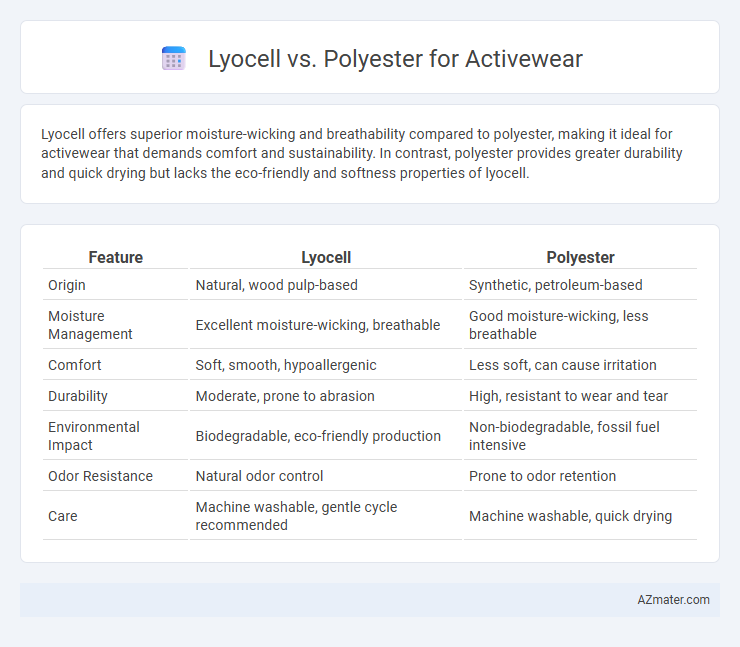Lyocell offers superior moisture-wicking and breathability compared to polyester, making it ideal for activewear that demands comfort and sustainability. In contrast, polyester provides greater durability and quick drying but lacks the eco-friendly and softness properties of lyocell.
Table of Comparison
| Feature | Lyocell | Polyester |
|---|---|---|
| Origin | Natural, wood pulp-based | Synthetic, petroleum-based |
| Moisture Management | Excellent moisture-wicking, breathable | Good moisture-wicking, less breathable |
| Comfort | Soft, smooth, hypoallergenic | Less soft, can cause irritation |
| Durability | Moderate, prone to abrasion | High, resistant to wear and tear |
| Environmental Impact | Biodegradable, eco-friendly production | Non-biodegradable, fossil fuel intensive |
| Odor Resistance | Natural odor control | Prone to odor retention |
| Care | Machine washable, gentle cycle recommended | Machine washable, quick drying |
Introduction to Lyocell and Polyester in Activewear
Lyocell, a sustainable fabric made from wood pulp, offers moisture-wicking, breathability, and softness, making it ideal for activewear designed for comfort and performance. Polyester, a durable synthetic fiber derived from petroleum, excels in moisture management, quick-drying, and elasticity, providing long-lasting support during intense physical activities. Both fabrics are popular in activewear, with Lyocell favored for eco-friendly and skin-friendly properties, while polyester is known for resilience and affordability.
Fabric Composition and Manufacturing Processes
Lyocell activewear is primarily composed of cellulose fibers derived from sustainably sourced wood pulp, using a closed-loop solvent spinning process that recycles water and chemicals, minimizing environmental impact. Polyester activewear consists of synthetic polymers, typically polyethylene terephthalate (PET), produced through petrochemical-based polymerization and melt spinning, resulting in durable and moisture-wicking fabrics. The eco-friendly lyocell manufacturing contrasts with the energy-intensive polyester production, influencing breathability, biodegradability, and overall sustainability of the activewear fabrics.
Moisture-Wicking and Breathability Comparison
Lyocell boasts superior moisture-wicking capabilities compared to polyester, effectively drawing sweat away from the skin to keep athletes dry and comfortable during intense workouts. The fabric's highly breathable cellulose fibers enhance airflow, preventing overheating and promoting quick drying, making it ideal for activewear. Polyester, while durable and moisture-resistant, tends to trap heat and retains odors due to its synthetic structure, which can compromise breathability and long-term freshness.
Comfort and Skin Sensitivity
Lyocell offers superior softness and breathability compared to polyester, making it ideal for activewear that demands comfort during intense workouts. Its moisture-wicking properties and hypoallergenic nature reduce skin irritation, benefiting sensitive skin types. Polyester, while durable and moisture-resistant, often traps heat and can cause chafing or discomfort for long-duration wear.
Durability and Performance in Activewear
Lyocell offers superior breathability and moisture-wicking properties compared to polyester, enhancing comfort during intense workouts. Polyester excels in durability, resisting abrasion and retaining shape through repeated washes, making it ideal for high-impact activities. Combining Lyocell's natural softness with polyester's resilience creates activewear that balances performance and longevity.
Sustainability and Environmental Impact
Lyocell, derived from sustainably sourced wood pulp, offers a biodegradable and environmentally friendly alternative to polyester, which is petroleum-based and non-biodegradable. The closed-loop production process of Lyocell minimizes chemical waste and water usage, significantly reducing its ecological footprint compared to polyester's energy-intensive manufacturing. Activewear made from Lyocell provides superior moisture-wicking and breathability while supporting sustainable fashion practices, unlike polyester, whose microplastic shedding contributes to marine pollution.
Care, Maintenance, and Longevity
Lyocell activewear offers superior breathability and moisture-wicking properties that enhance comfort during workouts, while polyester excels in durability and resistance to abrasion, making it a low-maintenance choice. Washing Lyocell in cold water and air drying helps maintain fiber integrity and extends garment lifespan, whereas polyester withstands frequent washing and dries quickly without losing shape or color. Both fabrics require proper care but polyester generally ensures longer-lasting performance under intense use, making it ideal for high-frequency athletic wear.
Cost Comparison: Lyocell vs Polyester
Lyocell activewear typically costs more than polyester due to its sustainable production process and biodegradable properties, making it a premium choice for eco-conscious consumers. Polyester is significantly cheaper to produce and widely available, resulting in lower retail prices and higher affordability for mass-market activewear. Despite higher upfront costs, lyocell's durability and moisture-wicking capabilities can provide better value over time compared to polyester.
Popular Activewear Brands Using Lyocell or Polyester
Popular activewear brands like Lululemon and Patagonia increasingly incorporate Lyocell due to its moisture-wicking, breathable, and sustainable properties, offering superior comfort and environmental benefits. In contrast, brands such as Nike and Adidas predominantly use polyester for its durability, elasticity, and cost-effectiveness, ensuring performance in high-intensity workouts. The choice between Lyocell and polyester by these leading brands reflects a balance between sustainability and performance criteria preferred by activewear consumers.
Choosing the Best Fabric for Your Active Lifestyle
Lyocell offers superior breathability and moisture-wicking properties, making it ideal for activewear that demands comfort and temperature regulation. Polyester provides durability and quick-drying capabilities, often favored for high-intensity workouts and frequent use. Selecting the best fabric depends on prioritizing natural fiber benefits in Lyocell or the resilience and performance of synthetic Polyester for your active lifestyle.

Infographic: Lyocell vs Polyester for Activewear
 azmater.com
azmater.com